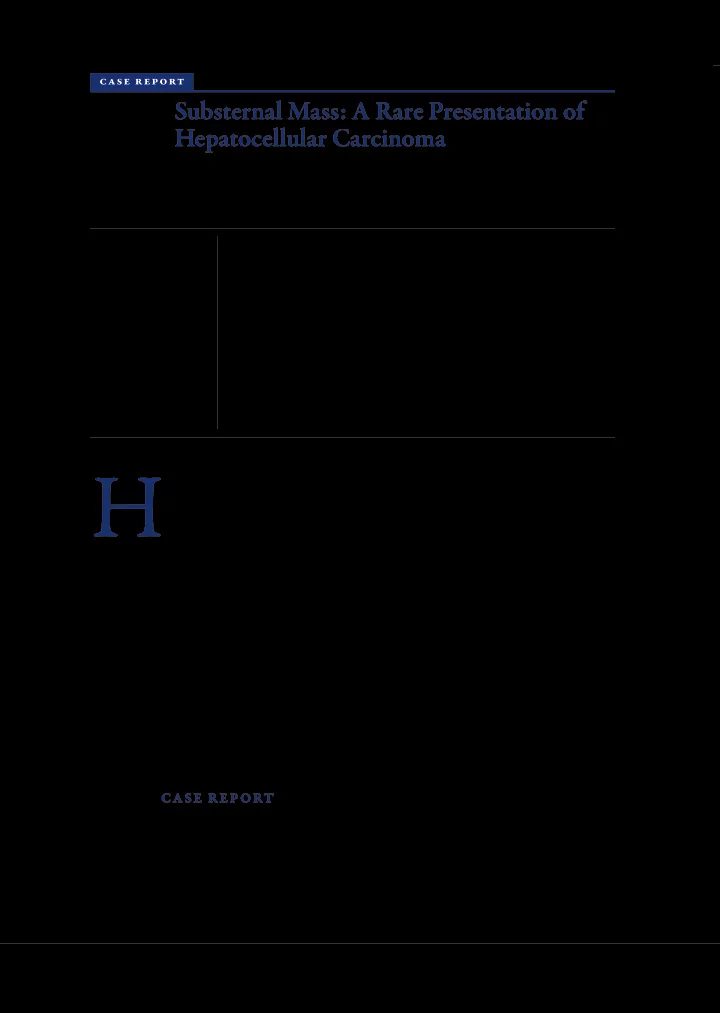

case report Oman medical Journal [2019], vol. 34, no. 6: 560-563 Substernal Mass: A Rare Presentation of Hepatocellular Carcinoma Kevin Yuqi Wang 1 , Mohammad Ghasemi Rad 1 *, Camelia Arsene 2 and Doina David 3 1 Department of Radiology, Baylor College of Medicine, Houston, Texas, USA 2 Department of Internal Medicine, Wayne State School of Medicine, Michigan, USA 3 Department of Pathology, Wayne State School of Medicine, Michigan, USA ARTICLE INFO ABSTR ACT Article history: a 62-year-old female with a history of hepatitis C presented with one week of worsening Received: 22 August 2017 abdominal distension. On physical examination, she had icterus, abdominal distension, Accepted: 3 September 2018 shifuing dullness, and a positive fmuid wave. Computed tomography (CT) of the abdomen and pelvis demonstrated a small lefu hepatic lobe lesion and moderate ascites. Chest CT Online: DOI 10.5001/omj.2019.101 demonstrated a large substernal mass (3.5 × 1.7 cm) in the anterior mediastinal fat in the region of prepericardial lymph nodes. Following resection of the substernal mass, Keywords: histopathology revealed metastatic involvement by poorly difgerentiated hepatocellular Hepatocellular Carcinoma; carcinoma (HCC). The patient was in fulminant liver failure postoperatively and Liver Cirrhosis; Hepatitis C. succumbed to her disease. mediastinal lymph nodes metastases in HCC are rare and ofuen portend a poor prognosis when present. We discuss a case of HCC presenting with a substernal mass, and provide a literature review of the management and prognosis of lymphatic spread of HCC. H epatocellular carcinoma (HCC) is the review of systems was positive for one week of fjfuh most common cancer worldwide constipation and one episode of non-bloody, non- and the third most common cause bilious vomiting three days before presentation, and of cancer-related deaths. Common an episode of hematuria without dysuria on the day etiologies for HCC include hepatitis b, chronic of presentation. She presented to her primary care hepatitis C, cirrhosis of any underlying etiology, physician four days before arriving at the ed, and and hereditary hemochromatosis. although HCC was prescribed acetaminophen, ciprofmoxacin, and is the most common primary hepatic malignancy, docusate with minimal interval improvement. the risk of extra-hepatic metastases is relatively low Her medical history was significant for compared to other primary hepatic malignancies. chronic hepatitis C diagnosed two years prior, Tie most common sites of malignant spread by HCC hypothyroidism, chronic obstructive pulmonary are the lungs, followed by intra-abdominal lymph disease, hypertension, type II diabetes mellitus, and nodes, bones, and adrenal glands. 1,2 Involvement of osteoarthritis of bilateral knees. Of note, she does intra-thoracic lymph nodes is rare. In this report, not have a documented prior history of varices or we present a case of poorly differentiated HCC gastrointestinal bleeding. Past surgical history was found to demonstrate metastatic involvement of the signifjcant for a percutaneous liver biopsy performed prepericardial lymph nodes. two years prior, which was reported by the patient to be benign. She had a 30-pack year history of smoking. She denied alcohol or intravenous drug CASE REPORT use. Tie patient reported nonadherence to hepatitis a 62-year-old female presented to the emergency C treatment at the time of presentation. department (ed) with one week of progressively Physical exam was notable for mild distress, but worsening abdominal pain and distension. Her the patient was alert and oriented and responding pain was located in the lefu upper quadrant, radiated appropriately. Tiere was mild scleral and oral mucosal to her back, was 10/10 in severity, and sharp in icterus. Tie abdomen was markedly distended, fjrm quality. Her pain was aggravated by lying down to touch, and dull to percussion in all four quadrants. or rising from bed and alleviated by staying still. Tiere were normal bowel sounds on auscultation, *Corresponding author: mdghrad@gmail.com
561 Kevin Yuqi Wang, et al. Figure 2: Transverse imaging of a contrast- enhanced CT chest demonstrates a well-marginated homogeneous sofu-tissue density mass measuring 3.5 × 1.7 cm in the mediastinal fat anterior to the right ventricle and the region of the prepericardial lymph Figure 1: Coronal imaging of a contrast-enhanced nodes (red arrow). abdomen and pelvis CT during the delayed-phase demonstrates subtle nodularity of the liver contour suggestive of cirrhosis. A nonspecifjc hypodense Pertinent laboratory tests included an alanine lesion in the medial portion of the lefu hepatic lobe, aminotransferase of 483 units/l, aspartate likely in hepatic segment IV, is seen on the delayed- aminotransferase of 139 units/l, Ca125 of 233 phase that was not conspicuously present on either units/ml, and alpha-fetoprotein of 3673 ng/ml. arterial- or venous-phase (red arrow). Moderate free Carcinoembryonic antigen was within normal limits. fmuid in the abdomen and pelvis was present and can be seen in the right subphrenic space and Morrison’s Contrast-enhanced computed tomography pouch in this image. (CT) of the abdomen and pelvis during the delayed- phase showed a well-defined 1–2 cm hypodense and there was no pain on superficial palpation. lesion in hepatic segment Iv [Figure 1] that was Signifjcant pain was elicited with deep palpation in not conspicuous on either arterial- or venous-phase. the lefu upper quadrant, but no rebound tenderness moderate amount of ascites, most notably in the or guarding was present. no asterixis was present. right paracolic gutter, was also present. Tiere was Tiere was no appreciable caput medusa, clubbing, no evidence of gastric, splenic, or esophageal varices. palmar erythema, or spider telangiectasias. Tiere was no recanalization of the paraumbilical vein, Figure 3: (a) Tumor cells showed strong positivity for low molecular weight cytokeratin CAM 5.2 (CAM 5.2 IHC stain, magnifjcation = 10 ×). (b) Strong positive staining for glypican-3 (glypican-3 IHC stain, magnifjcation = 10 ×). (c) Tumor cells also showed focal positivity for Hepar-1 (Hepar-1 IHC stain, magnifjcation = 10 ×). Tie tumor cells are negative for vimentin, neuron-specifjc enolase, chromogranin, CD117, PLAP, HDL, HCG, CD30, desmin, TTF-1, and S100. Oman med J, vOl 34, nO 6, nOvember 2019
Recommend
More recommend